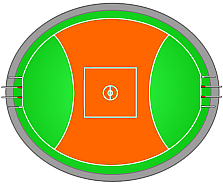glossary of terms
Australian Football has developed a unique and rich terminology.
This list is an alphabetical glossary of terms, jargon and slang.
M
- maggies
- the magpies , an afl team from collingwood , melbourne vic
- Car'n the maggies!
- magoos
- the reserve team
- Also known as the Twos, or nicknamed the Ressies.
-
rhyming slang: magoos for twos
- man-on-man
- a traditional defensive technique
- A defender who plays close to an opposition forward.
The opposite of zone-off. - man in white
- an aussie rules umpire
 Less affectionately known as a
Less affectionately known as a
white maggot.obsolete: umpires now wear coloured uniforms
- main contest
- a point of play where the ball is in contest between the opposing players
- major
- a goal
- mark
- catching or taking control of the football
-
One of the most distinctive features of the game, it is a skill where a player cleanly catches (i.e. is deemed to have controlled the ball for sufficient time) a kicked ball that has travelled more than 15 metres without anyone else touching it or the ball hitting the ground.
14.1 Definition A Mark is taken if, in the opinion of the field Umpire, a Player catches or takes control of the football:
(a) within the Playing Surface;
(b) after it has been Kicked by another Player a distance of at least 15 metres; and
(c) which has not touched the ground or been touched by another Player during the period from when the football was Kicked until it was caught or controlled by the Player.
Upon marking the ball a player is entitled to an unimpeded kick.  The nearest opposition player stands on the spot (also known as the mark) where the player marked the ball, and becomes the man on the mark. A player may choose to play on, forfeiting the set shot in the hope of pressing an advantage for his team, rather than allowing the opposition to reposition while he prepares for the free kick.
The nearest opposition player stands on the spot (also known as the mark) where the player marked the ball, and becomes the man on the mark. A player may choose to play on, forfeiting the set shot in the hope of pressing an advantage for his team, rather than allowing the opposition to reposition while he prepares for the free kick.
Once a player has chosen to play on, normal play resumes and the player who took the mark is again able to be tackled.The criterion for a mark is that it be caught cleanly, i.e. the player must have complete control of the ball, for any length of time. As such, if the ball is caught in one grab, and then punched out from between the player's hands, a mark is paid, even if he has held it for only an instant. Similarly, if a ball is controlled, and then dislodged by another player or the ground, the mark will still be paid. Although the rules make no provision for two players mark the ball simultaneously, by convention the umpire will award the mark to the player who has the front position in the marking contest; if he cannot determine which player is in front, then a ball-up will result. Some people claim that the origin of the term comes from the practice of a player who has just taken a mark physically marking the ground with his foot or cap to show where he took the fair catch. Others claim that the origin of the term comes from the game of marngrook, where jumping to catch the ball is called mumarki, an Aboriginal word meaning "to catch".- marngrook
- a first nations' football game
- The name given to the traditional games played at gatherings of up to fifty players, played over an extremely large area. Totemic teams were formed; however, to observers the game appeared to lack a team objective, having no real rules, scoring or winner.
Individual players who consistently exhibited outstanding skills, such as leaping high over others to mumarki meaning “to catch” were often commented on. Games were played by the Djabwurrung and Jardwadjali people and others in western Victoria, and the Wurundjeri in the Yarra Valley, the Gunai people of Gippsland, and the Riverina in south-western New South Wales.
The Warlpiri tribe of Central Australia played a very similar kicking and catching game with possum skins known as pultja. The game had a role in the formation of Australian rules football. This connection has become culturally important to many First Nations Australians, including celebrities and professional footballers from communities in which Australian rules football is highly popular. -
game ball: gunditjmara language

- melee
- an unacceptable gathering of players involved in deliberate physical contact
- Can lead to suspensions and fines.
- midfield
- the area between the two fifty metre arcs

- midfielder
- a player who roams and plays within the midfield
- mine!
- a call by the field umpire
- Called when the football is caught in a contest and in the umpires' opinion the ball can not escape. The umpire will then perform a ball-up or a bounce to recommence play.
- mongrel
- a tumbling , awkward-looking kick
Australian Football has developed a unique and rich terminology.
This list is an alphabetical glossary of terms, jargon and slang.





















